Adsorption Characteristics of Phosphate Ions by Pristine, CaCl2 and FeCl3-Activated Biochars Originated from Tangerine Peels
Abstract
1. Introduction
2. Materials and Methods
2.1. Chemicals and Reagents
2.2. Preparation of Tangerine Peel Biochars
2.3. Characteristics of Tangerine Peel Biochars
2.4. Adsorption Experiments
2.4.1. Optimal Dosage
2.4.2. Adsorption Kinetics
2.4.3. Adsorption Isotherm
2.4.4. Effects of pH and Ionic Strength
2.4.5. Effects of Temperature
3. Results and Discussions
3.1. Characterization of TB, CTB, and FTB
3.1.1. Elemental Composition and Functionality Analyses
3.1.2. UH-SEM-EDX and XRD Analyses
3.2. Effects of Tangerine Peel Biochar Dosage
3.3. Adsorption Kinetics
3.4. Adsorption Isotherms
3.5. Effects of pH on Adsorption of PO43−
3.6. Effects of Ionic Strength on Adsorption of PO43−
3.7. Effects of Temperature and Thermodynamic Analysis
4. Conclusions
Author Contributions
Funding
Conflicts of Interest
References
- Kılıc, M.; Kırbıyık, C.; Çepelioğullar, Ö.; Pütün, A.E. Adsorption of heavy metal ions from aqueous solutions by bio-char, a by-product of pyrolysis. Appl. Surf. Sci. 2013, 283, 856–862. [Google Scholar] [CrossRef]
- Bishop, M.J.; Powers, S.P.; Porter, H.J.; Peterson, C.H. Benthic biological effects of seasonal hypoxia in a eutrophic estuary predate rapid coastal development. Estuar. Coast. Shelf Sci. 2006, 70, 415–422. [Google Scholar] [CrossRef]
- Withers, P.J.; Neal, C.; Jarvie, H.P.; Doody, D.G. Agriculture and eutrophication: Where do we go from here? Sustainability 2014, 6, 5853–5875. [Google Scholar] [CrossRef]
- Carpenter, S.R.; Caraco, N.F.; Correll, D.L.; Howarth, R.W.; Sharpley, A.N.; Smith, V.H. Nonpoint pollution of surface waters with phosphorus and nitrogen. Ecol. Appl. 1998, 8, 559–568. [Google Scholar] [CrossRef]
- Bennett, E.M.; Carpenter, S.R.; Caraco, N.F. Human impact on erodable phosphorus and eutrophication: A global perspective: Increasing accumulation of phosphorus in soil threatens rivers, lakes, and coastal oceans with eutrophication. BioScience 2001, 51, 227–234. [Google Scholar] [CrossRef]
- Oguz, E. Thermodynamic and kinetic investigations of PO3−4 adsorption on blast furnace slag. J. Colloid Interface Sci. 2005, 281, 62–67. [Google Scholar] [CrossRef] [PubMed]
- Chubar, N.; Kanibolotskyy, V.; Strelko, V.; Gallios, G.; Samanidou, V.; Shaposhnikova, T.; Milgrandt, V.; Zhuravlev, I. Adsorption of phosphate ions on novel inorganic ion exchangers. Colloids Surf. A Physicochem. Eng. Asp. 2005, 255, 55–63. [Google Scholar] [CrossRef]
- Abu-Alhail, S.; Lu, X.W. Experimental investigation and modeling of innovative five-tank anaerobic-anoxic/oxic process. Appl. Math. Model. 2014, 38, 278–290. [Google Scholar] [CrossRef]
- Mohan, D.; Pittman, C.U., Jr. Arsenic removal from water/wastewater using adsorbents—A critical review. J. Hazard. Mater. 2007, 142, 1–53. [Google Scholar] [CrossRef]
- Seida, Y.; Nakano, Y. Removal of phosphate by layered double hydroxides containing iron. Water Res. 2002, 36, 1306–1312. [Google Scholar] [CrossRef]
- Zhang, L.; Xu, C.; Champagne, P.; Mabee, W. Overview of current biological and thermo-chemical treatment technologies for sustainable sludge management. Waste Manag. Res. 2014, 32, 586–600. [Google Scholar] [CrossRef] [PubMed]
- Ayranci, E.; Hoda, N. Adsorption of bentazon and propanil from aqueous solutions at the high area activated carbon-cloth. Chemosphere 2004, 57, 755–762. [Google Scholar] [CrossRef] [PubMed]
- Das, J.; Patra, B.S.; Baliarsingh, N.; Parida, K.M. Adsorption of phosphate by layered double hydroxides in aqueous solutions. Appl. Clay Sci. 2006, 32, 252–260. [Google Scholar] [CrossRef]
- Chen, J.; Kong, H.; Wu, D.; Chen, X.; Zhang, D.; Sun, Z. Phosphate immobilization from aqueous solution by fly ashes in relation to their composition. J. Hazard. Mater. 2007, 139, 293–300. [Google Scholar] [CrossRef]
- Zhang, L.; Wan, L.; Chang, N.; Liu, J.; Duan, C.; Zhou, Q.; Li, X.; Wang, X. Removal of phosphate from water by activated carbon fiber loaded with lanthanum oxide. J. Hazard. Mater. 2011, 190, 848–855. [Google Scholar] [CrossRef] [PubMed]
- Yuan, M.; Tong, S.; Zhao, S.; Jia, C.Q. Adsorption of polycyclic aromatic hydrocarbons from water using petroleum coke-derived porous carbon. J. Hazard. Mater. 2010, 181, 1115–1120. [Google Scholar] [CrossRef]
- Yin, Q.; Ren, H.; Wang, R.; Zhao, Z. Evaluation of nitrate and phosphate adsorption on Al-modified biochar: Influence of Al content. Sci. Total Environ. 2018, 631–632, 895–903. [Google Scholar] [CrossRef]
- Yao, Y.; Gao, B.; Zhang, M.; Inyang, M.; Zimmerman, A.R. Effect of biochar amendment on sorption and leaching of nitrate, ammonium, and phosphate in a sandy soil. Chemosphere 2012, 89, 1467–1471. [Google Scholar] [CrossRef]
- Zhou, Y.; Gao, B.; Zimmerman, A.R.; Chen, H.; Zhang, M.; Cao, X. Biochar-supported zerovalent iron for removal of various contaminants from aqueous solutions. Bioresour. Technol. 2014, 152, 538–542. [Google Scholar] [CrossRef]
- Kim, Y.-M.; Lee, H.W.; Lee, S.-H.; Kim, S.-S.; Park, S.H.; Jeon, J.-K.; Kim, S.; Park, Y.-K. Pyrolysis properties and kinetics of mandarin peel. Korean J. Chem. Eng. 2011, 28, 2012–2016. [Google Scholar] [CrossRef]
- Biswas, B.K.; Inoue, J.-i.; Inoue, K.; Ghimire, K.N.; Harada, H.; Ohto, K.; Kawakita, H. Adsorptive removal of As(V) and As(III) from water by a Zr(IV)-loaded orange waste gel. J. Hazard. Mater. 2008, 154, 1066–1074. [Google Scholar] [CrossRef]
- Li, X.; Tang, Y.; Cao, X.; Lu, D.; Luo, F.; Shao, W. Preparation and evaluation of orange peel cellulose adsorbents for effective removal of cadmium, zinc, cobalt and nickel. Colloids Surf. A Physicochem. Eng. Asp. 2008, 317, 512–521. [Google Scholar] [CrossRef]
- Chen, B.; Chen, Z.; Lv, S. A novel magnetic biochar efficiently sorbs organic pollutants and phosphate. Bioresour. Technol. 2011, 102, 716–723. [Google Scholar] [CrossRef] [PubMed]
- Zhang, M.; Gao, B. Removal of arsenic, methylene blue, and phosphate by biochar/AlOOH nanocomposite. Chem. Eng. J. 2013, 226, 286–292. [Google Scholar] [CrossRef]
- Yao, Y.; Gao, B.; Chen, J.; Yang, L. Engineered biochar reclaiming phosphate from aqueous solutions: Mechanisms and potential application as a slow-release fertilizer. Environ. Sci. Technol. 2013, 47, 8700–8708. [Google Scholar] [CrossRef] [PubMed]
- Choi, Y.-K.; Jang, H.M.; Kan, E.; Wallace, A.R.; Sun, W. Adsorption of phosphate in water on a novel calcium hydroxide-coated dairy manure-derived biochar. Environ. Eng. Res. 2019, 24, 434–442. [Google Scholar] [CrossRef]
- Fang, C.; Zhang, T.; Li, P.; Jiang, R.-f.; Wang, Y.-c. Application of magnesium modified corn biochar for phosphorus removal and recovery from swine wastewater. Int. J. Environ. Res. Public Health 2014, 11, 9217–9237. [Google Scholar] [CrossRef] [PubMed]
- Ren, J.; Li, N.; Li, L.; An, J.-K.; Zhao, L.; Ren, N.-Q. Granulation and ferric oxides loading enable biochar derived from cotton stalk to remove phosphate from water. Bioresour. Technol. 2015, 178, 119–125. [Google Scholar] [CrossRef]
- Qian, L.; Zhang, W.; Yan, J.; Han, L.; Gao, W.; Liu, R.; Chen, M. Effective removal of heavy metal by biochar colloids under different pyrolysis temperatures. Bioresour. Technol. 2016, 206, 217–224. [Google Scholar] [CrossRef] [PubMed]
- Towns, T.G. Determination of aqueous phosphate by ascorbic acid reduction of phosphomolybdic acid. Anal. Chem. 1986, 58, 223–229. [Google Scholar] [CrossRef]
- Bhainsa, K.C.; D’souza, S. Removal of copper ions by the filamentous fungus, Rhizopus oryzae from aqueous solution. Bioresour. Technol. 2008, 99, 3829–3835. [Google Scholar] [CrossRef]
- Gorgievski, M.; Božić, D.; Stanković, V.; Štrbac, N.; Šerbula, S. Kinetics, equilibrium and mechanism of Cu2+, Ni2+ and Zn2+ ions biosorption using wheat straw. Ecol. Eng. 2013, 58, 113–122. [Google Scholar] [CrossRef]
- Lee, J.-J. Study on equilibrium, kinetic and thermodynamic for adsorption of quinoline yellow by granular activated carbon. Clean Technol. 2014, 20, 35–41. [Google Scholar] [CrossRef][Green Version]
- Chen, S.; Qin, C.; Wang, T.; Chen, F.; Li, X.; Hou, H.; Zhou, M. Study on the adsorption of dyestuffs with different properties by sludge-rice husk biochar: Adsorption capacity, isotherm, kinetic, thermodynamics and mechanism. J. Mol. Liq. 2019, 285, 62–74. [Google Scholar] [CrossRef]
- Li, M.; Zhao, Z.; Wu, X.; Zhou, W.; Zhu, L. Impact of mineral components in cow manure biochars on the adsorption and competitive adsorption of oxytetracycline and carbaryl. RSC Adv. 2017, 7, 2127–2136. [Google Scholar] [CrossRef]
- Luo, L.; Wang, G.; Shi, G.; Zhang, M.; Zhang, J.; He, J.; Xiao, Y.; Tian, D.; Zhang, Y.; Deng, S. The characterization of biochars derived from rice straw and swine manure, and their potential and risk in N and P removal from water. J. Environ. Manag. 2019, 245, 1–7. [Google Scholar] [CrossRef]
- Liu, J.; Zhou, Q.; Chen, J.; Zhang, L.; Chang, N. Phosphate adsorption on hydroxyl–iron–lanthanum doped activated carbon fiber. Chem. Eng. J. 2013, 215, 859–867. [Google Scholar] [CrossRef]
- Zhao, J.; Shen, X.-J.; Domene, X.; Alcañiz, J.-M.; Liao, X.; Palet, C. Comparison of biochars derived from different types of feedstock and their potential for heavy metal removal in multiple-metal solutions. Sci. Rep. 2019, 9, 9869. [Google Scholar] [CrossRef]
- Binda, G.; Spanu, D.; Bettinetti, R.; Magagnin, L.; Pozzi, A.; Dossi, C. Comprehensive comparison of microalgae-derived biochar from different feedstocks: A prospective study for future environmental applications. Algal Res. 2020, 52, 102103. [Google Scholar] [CrossRef]
- Wang, S.; Zhao, C.; Shan, R.; Wang, Y.; Yuan, H. A novel peat biochar supported catalyst for the transesterification reaction. Energy Convers. Manag. 2017, 139, 89–96. [Google Scholar] [CrossRef]
- Shakir, I.; Sarfraz, M.; Ali, Z.; Aboud, M.F.; Agboola, P.O. Magnetically separable and recyclable graphene-MgFe2O4 nanocomposites for enhanced photocatalytic applications. J. Alloy Compd. 2016, 660, 450–455. [Google Scholar] [CrossRef]
- Banerjee, S.; Mukherjee, S.; LaminKa-ot, A.; Joshi, S.R.; Mandal, T.; Halder, G. Biosorptive uptake of Fe2+, Cu2+ and As5+ by activated biochar derived from Colocasia esculenta: Isotherm, kinetics, thermodynamics, and cost estimation. J. Adv. Res. 2016, 7, 597–610. [Google Scholar] [CrossRef]
- Almasi, A.; Omidi, M.; Khodadadian, M.; Khamutian, R.; Gholivand, M.B. Lead (II) and cadmium (II) removal from aqueous solution using processed Walnut shell: Kinetic and equilibrium study. Toxicol. Environ. Chem. 2012, 94, 660–671. [Google Scholar] [CrossRef]
- Yan, H.; Shih, K. Effects of calcium and ferric ions on struvite precipitation: A new assessment based on quantitative X-ray diffraction analysis. Water Res. 2016, 95, 310–318. [Google Scholar] [CrossRef]
- Pellera, F.-M.; Giannis, A.; Kalderis, D.; Anastasiadou, K.; Stegmann, R.; Wang, J.-Y.; Gidarakos, E. Adsorption of Cu (II) ions from aqueous solutions on biochars prepared from agricultural by-products. J. Environ. Manag. 2012, 96, 35–42. [Google Scholar] [CrossRef]
- Mistar, E.; Ahmad, S.; Muslim, A.; Alfatah, T.; Supardan, M. Preparation and characterization of a high surface area of activated carbon from Bambusa vulgaris—Effect of NaOH activation and pyrolysis temperature. In Proceedings of the 3rd International Conference on Chemical Engineering Sciences and Applications 2017, Banda Aceh, Indonesia, 20–21 September 2017. [Google Scholar]
- Lee, K.-H.; Lee, Y.-G.; Shin, J.; Chon, K.; Lee, S.-H. Selective immobilization of antimony using brucite-rich precipitate produced during in situ hypochlorous acid formation through seawater electrolysis in a nuclear power plant. Energies 2020, 13, 4493. [Google Scholar] [CrossRef]
- Shin, J.; Kwak, J.; Lee, Y.-G.; Kim, S.; Choi, M.; Bae, S.; Lee, S.-H.; Park, Y.; Chon, K. Competitive adsorption of pharmaceuticals in lake water and wastewater effluent by pristine and NaOH-activated biochars from spent coffee wastes: Contribution of hydrophobic and π-π interactions. Environ. Pollut. 2021, 270, 116244. [Google Scholar] [CrossRef]
- Kim, H.; Ko, R.-A.; Lee, S.; Chon, K. Removal efficiencies of manganese and iron using pristine and phosphoric acid pre-treated biochars made from banana peels. Water 2020, 12, 1173. [Google Scholar] [CrossRef]
- Hayati, B.; Mahmoodi, N.M. Modification of activated carbon by the alkaline treatment to remove the dyes from wastewater: Mechanism, isotherm and kinetic. Desalination Water Treat. 2012, 47, 322–333. [Google Scholar] [CrossRef]
- Zhou, N.; Chen, H.; Xi, J.; Yao, D.; Zhou, Z.; Tian, Y.; Lu, X. Biochars with excellent Pb (II) adsorption property produced from fresh and dehydrated banana peels via hydrothermal carbonization. Bioresour. Technol. 2017, 232, 204–210. [Google Scholar] [CrossRef]
- Sarkhot, D.V.; Ghezzehei, T.A.; Berhe, A.A. Effectiveness of biochar for sorption of ammonium and phosphate from dairy effluent. J. Environ. Qual. 2013, 42, 1545–1554. [Google Scholar] [CrossRef]
- Liu, F.; Zuo, J.; Chi, T.; Wang, P.; Yang, B. Removing phosphorus from aqueous solutions by using iron-modified corn straw biochar. Front. Environ. Sci. Eng. 2015, 9, 1066–1075. [Google Scholar] [CrossRef]
- Ma, Y.; Liu, W.-J.; Zhang, N.; Li, Y.-S.; Jiang, H.; Sheng, G.-P. Polyethylenimine modified biochar adsorbent for hexavalent chromium removal from the aqueous solution. Bioresour. Technol. 2014, 169, 403–408. [Google Scholar] [CrossRef]
- Behera, S.; Oh, S.; Park, H. Sorptive removal of ibuprofen from water using selected soil minerals and activated carbon. Int. J. Environ. Sci. Technol. 2012, 9, 85–94. [Google Scholar] [CrossRef]
- Yan, L.; Liu, Y.; Zhang, Y.; Liu, S.; Wang, C.; Chen, W.; Liu, C.; Chen, Z.; Zhang, Y. ZnCl2 modified biochar derived from aerobic granular sludge for developed microporosity and enhanced adsorption to tetracycline. Bioresour. Technol. 2020, 297, 122381. [Google Scholar] [CrossRef]
- Dai, Y.; Zhang, K.; Meng, X.; Li, J.; Guan, X.; Sun, Q.; Sun, Y.; Wang, W.; Lin, M.; Liu, M.; et al. New use for spent coffee ground as an adsorbent for tetracycline removal in water. Chemosphere 2019, 215, 163–172. [Google Scholar] [CrossRef] [PubMed]
- Wang, B.; Jiang, Y.-s.; Li, F.-y.; Yang, D.-y. Preparation of biochar by simultaneous carbonization, magnetization and activation for norfloxacin removal in water. Bioresour. Technol. 2017, 233, 159–165. [Google Scholar] [CrossRef] [PubMed]
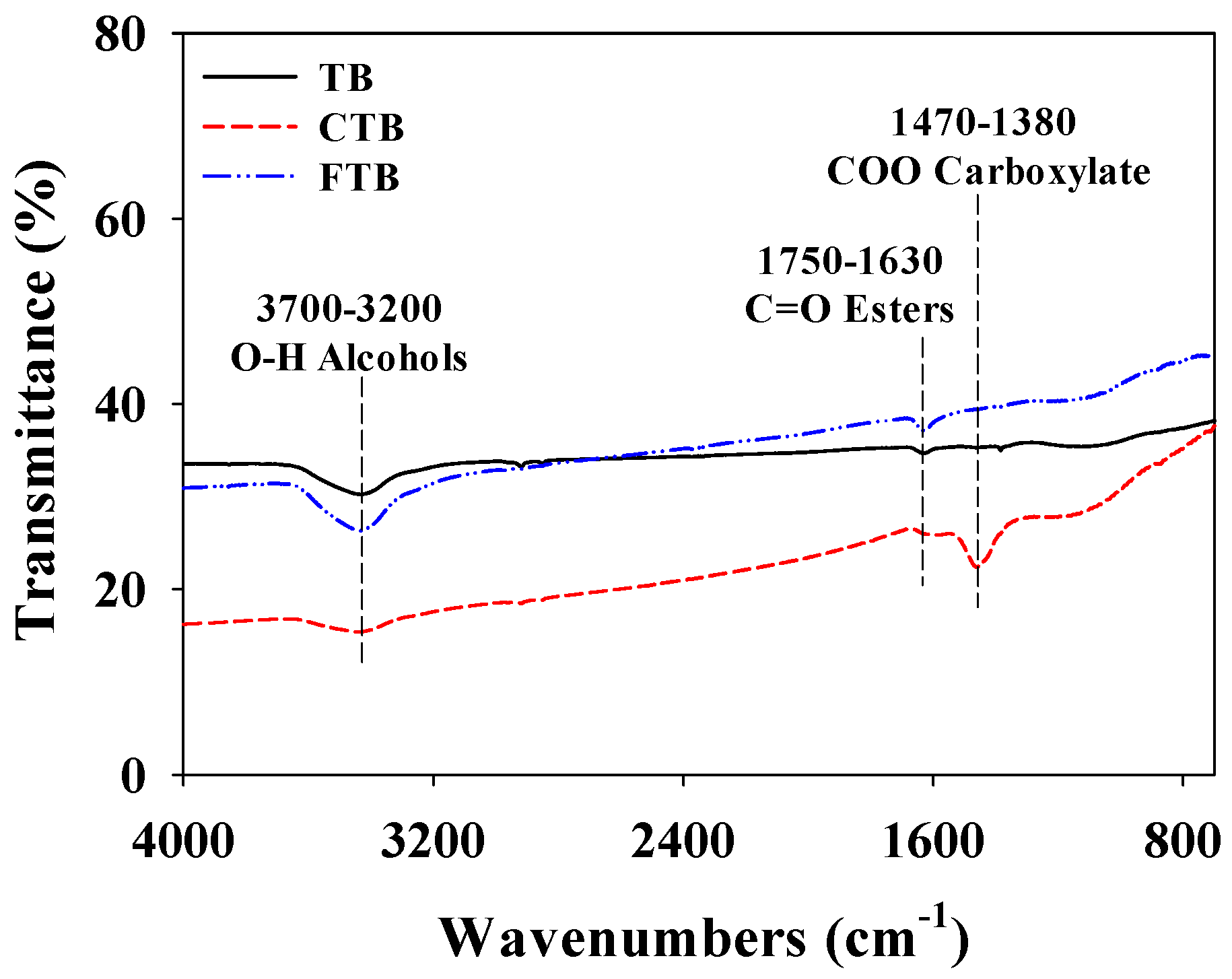


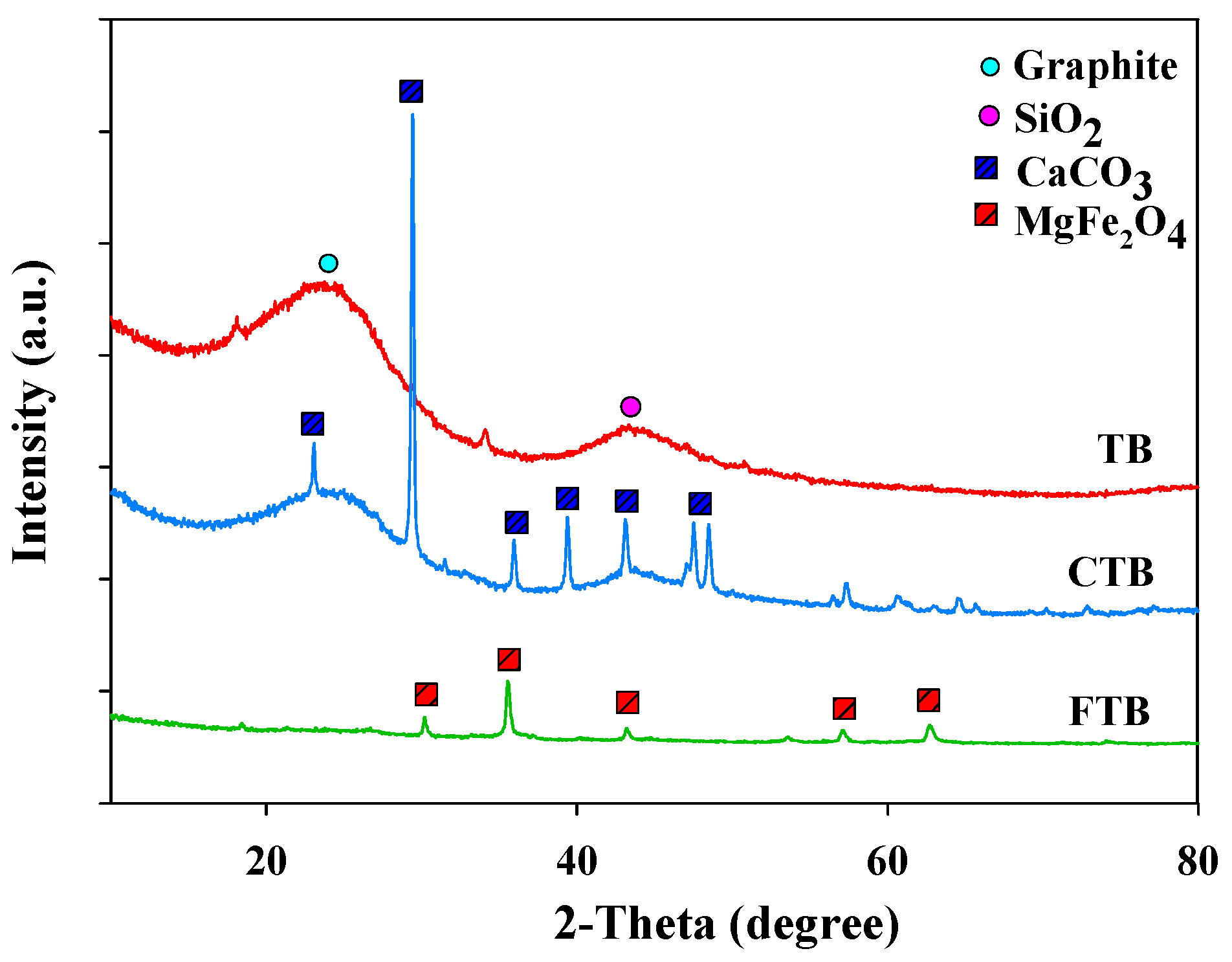
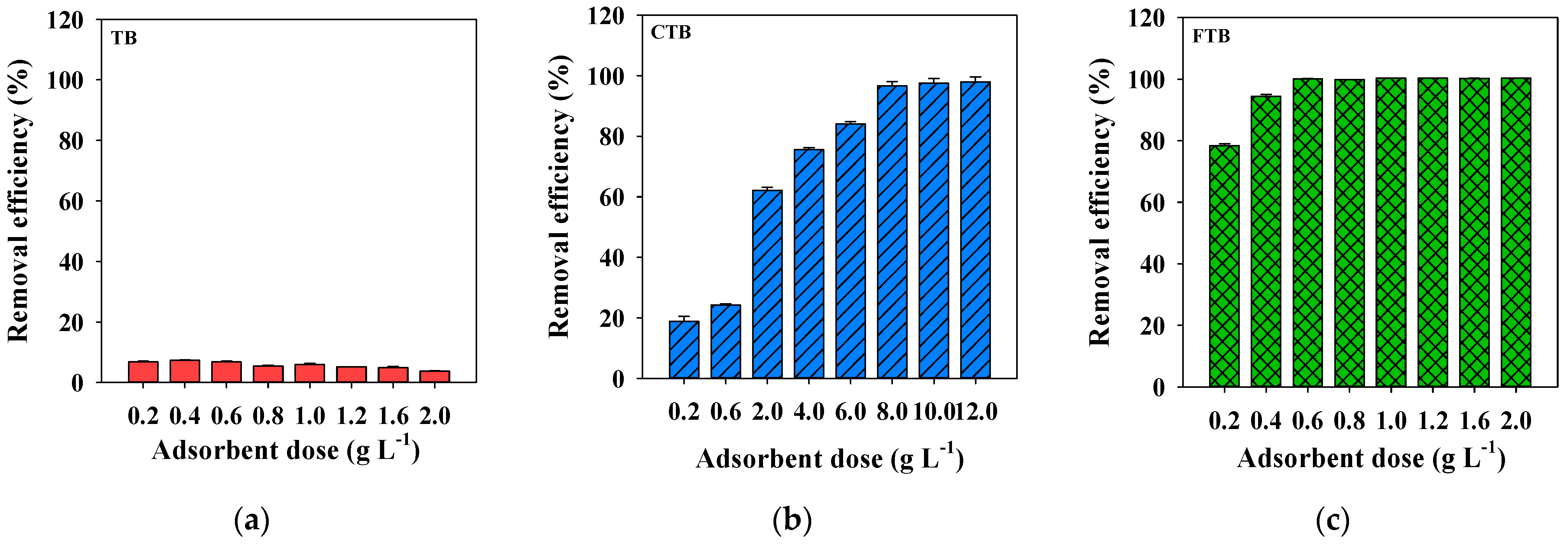
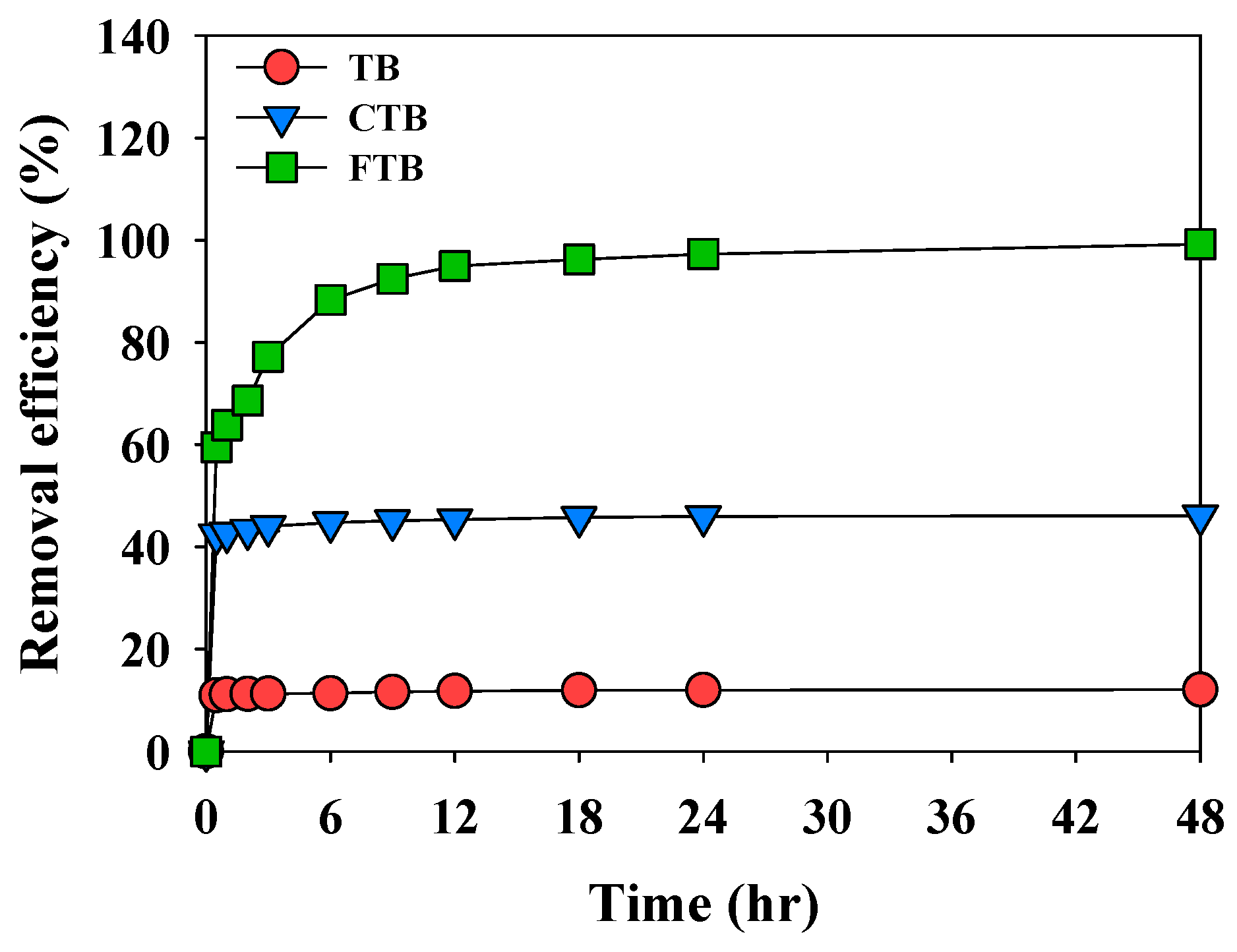
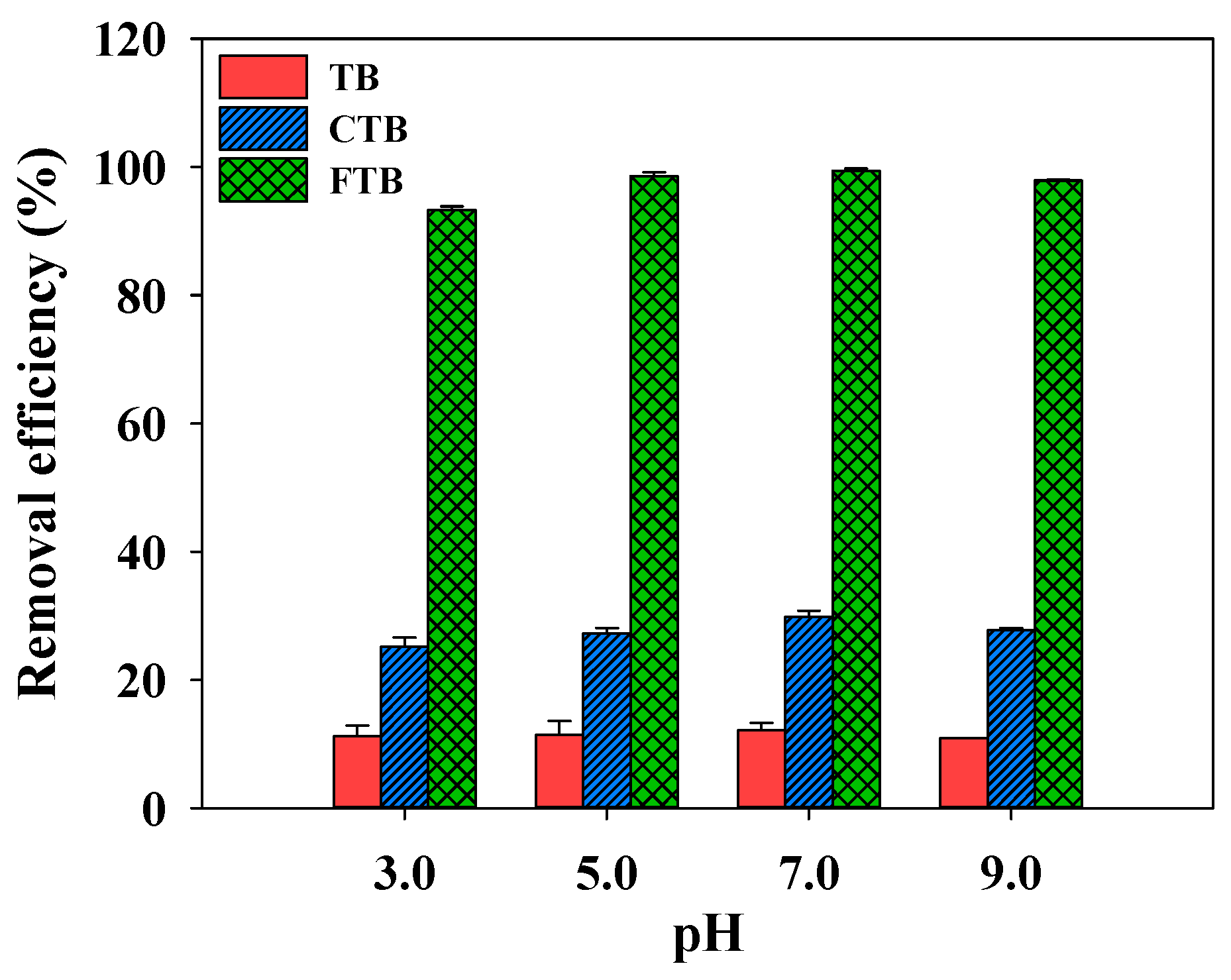
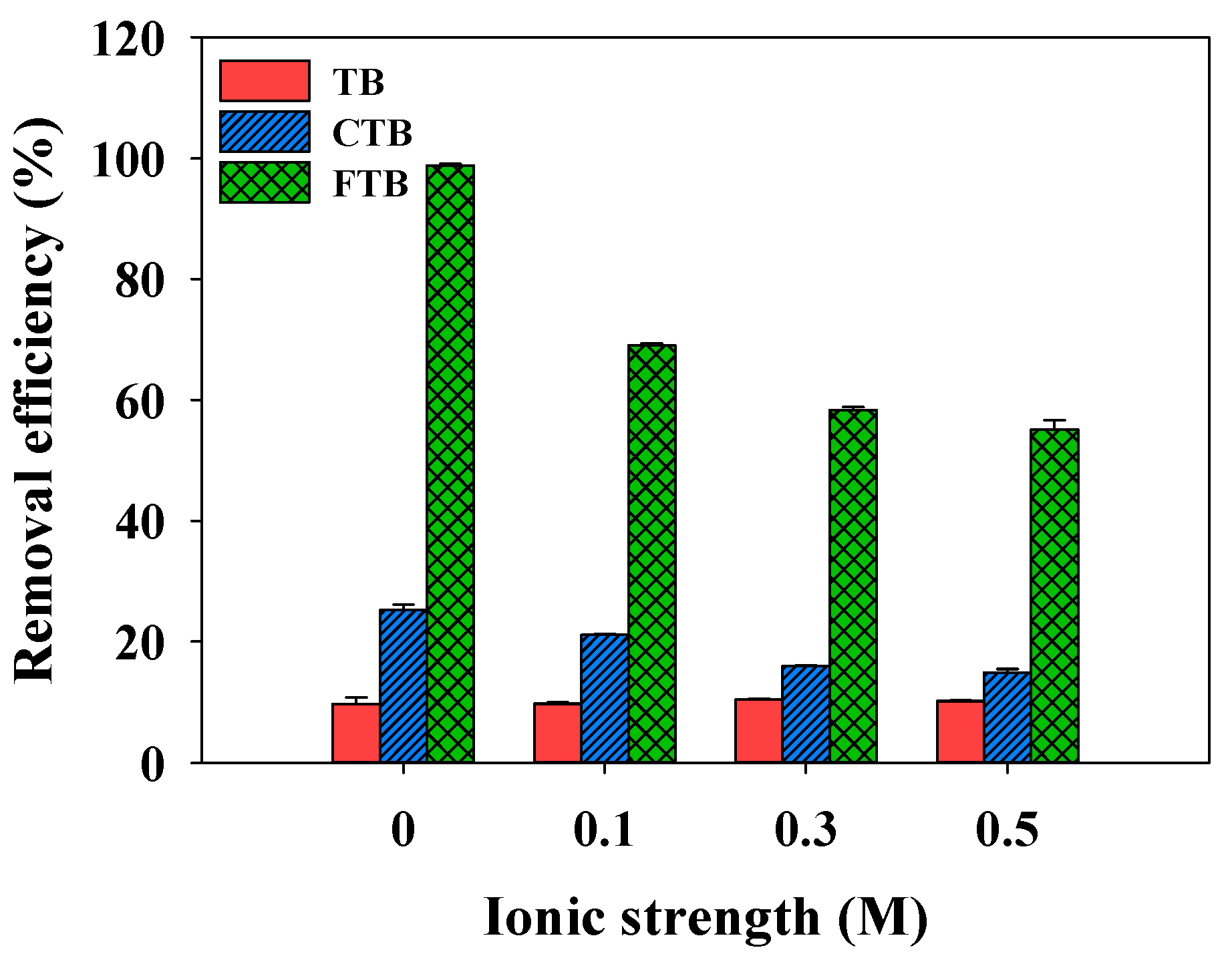
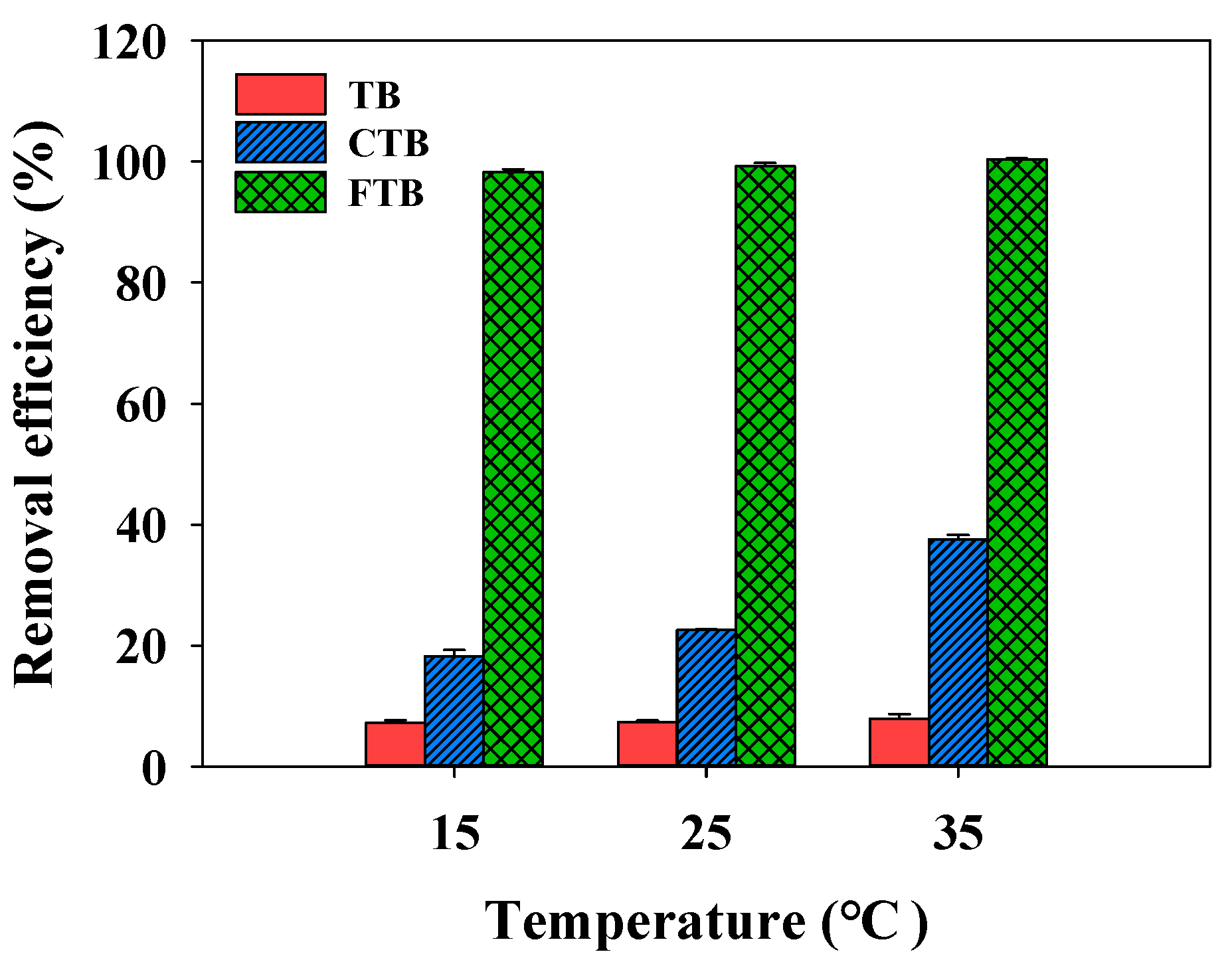
| Properties | TB | CTB | FTB |
|---|---|---|---|
| C (%) | 81.12 | 69.42 | 53.81 |
| H (%) | 1.50 | 1.94 | 1.63 |
| O (%) | 4.40 | 7.61 | 8.39 |
| N (%) | 2.09 | 1.31 | 1.05 |
| Ash (%) | 10.89 | 19.72 | 35.12 |
| H/C | 0.22 | 0.34 | 0.36 |
| O/C | 0.04 | 0.08 | 0.12 |
| N/C | 0.02 | 0.02 | 0.02 |
| PO43− (mg L−1) a | 0.019 ± 0.001 | 0.047 ± 0.001 | 0.009 ± 0.002 |
| SBET (m2 g−1) | 9.21 | 342.11 | 558.71 |
| Pore volume (cm3 g−1) | 0.01 | 0.36 | 0.18 |
| Pore size (nm) | 6.07 | 3.67 | 3.64 |
| Element | Atomic (%) | ||
|---|---|---|---|
| TB | CTB | FTB | |
| C | 69.85 | 55.68 | 72.26 |
| Ca | 29.67 | 42.71 | - |
| Fe | - | - | 21.38 |
| Cl | - | 1.61 | 6.36 |
| Mg | 0.48 | - | - |
| Total | 100.00 | 100.00 | 100.00 |
| Adsorbents | Qe, exp (mg g−1) | Pseudo-First-Order | Pseudo-Second-Order | ||||
|---|---|---|---|---|---|---|---|
| Qe, cal (mg g−1) | k1 | R2 | Qe, cal (mg g−1) | k2 | R2 | ||
| TB | 0.104 ±0.004 | 0.020 ±0.002 | 0.115 ±0.012 | 0.990 | 0.105 ±0.020 | 19.73 ±4.420 | 0.999 |
| CTB | 0.354 ±0.002 | 0.103 ±0.003 | 0.186 ±0.012 | 0.975 | 0.357 ±0 | 5.25 ±0.620 | 0.999 |
| FTB | 1.655 ±0.001 | 0.579 ±0.001 | 0.131 ±0.002 | 0.929 | 1.679 ±0.024 | 0.734 ±0.120 | 0.999 |
| Adsorbents | Langmuir | Freundlich | ||||
|---|---|---|---|---|---|---|
| Qmax (mg g−1) | KL (L mg−1) | R2 | n | KF (mg1−1/nL1/n g−1) | R2 | |
| TB | 1.540 ±0.035 | 0.080 ±0.004 | 0.887 | 0.766 ±0.022 | 0.139 ±0.002 | 0.975 |
| CTB | 3.608 ±0.011 | 0.173 ±0.013 | 0.889 | 1.523 ±0.003 | 0.539 ±0.007 | 0.955 |
| FTB | 5.434 ±0.035 | 3.786 ±0.140 | 0.987 | 7.530 ±0.257 | 3.680 ±0.084 | 0.912 |
| Biomass | Pyrolysis Temperature (°C) | Application Matrix | Modification Method | Initial Concentration (mg L−1) | Adsorption Capacity (mg g−1) | References |
|---|---|---|---|---|---|---|
| Mixed hardwood | 300 | Aqueous solution | - | 24 | 0.48 | [52] |
| Corn straw | 500 | Aqueous solution | FeSO4 | 7.5 | 7.35 | [53] |
| Ground corn | 600 | Aqueous solution | MgCl2 | 84 | 7.5 | [27] |
| Cotton stalks | 350 | Aqueous solution | FeCl3 | 20 | 0.96 | [28] |
| Tangerine peels | 800 | Aqueous solution | CaCl2 | 1 | 3.61 | This study |
| FeCl3 | 5.43 |
| Adsorbents | Thermodynamic Parameters | |||
|---|---|---|---|---|
| Temperature (K) | ∆G° (kJ mol−1) | ΔH° (kJ mol−1) | ΔS° (J mol−1 K) | |
| TB | 288 | −11.650 ±0.311 | 0.016 ±0.001 | 0.024 ±0.005 |
| 298 | −12.082 ±0.111 | |||
| 308 | −12.704 ±0.241 | |||
| CTB | 288 | −14.161 ±0.168 | 0.001 ±0.0005 | 0.107 ±0.001 |
| 298 | −15.322 ±0.014 | |||
| 308 | −17.688 ±0.074 | |||
| FTB | 288 | −18.996 ±0.321 | 0.001 ±0.0008 | 0.039 ±0.015 |
| 298 | −27.330 ±0.713 | |||
| 308 | −30.418 ±1.782 | |||
Publisher’s Note: MDPI stays neutral with regard to jurisdictional claims in published maps and institutional affiliations. |
© 2021 by the authors. Licensee MDPI, Basel, Switzerland. This article is an open access article distributed under the terms and conditions of the Creative Commons Attribution (CC BY) license (http://creativecommons.org/licenses/by/4.0/).
Share and Cite
Son, C.; An, W.; Lee, G.; Jeong, I.; Lee, Y.-G.; Chon, K. Adsorption Characteristics of Phosphate Ions by Pristine, CaCl2 and FeCl3-Activated Biochars Originated from Tangerine Peels. Separations 2021, 8, 32. https://doi.org/10.3390/separations8030032
Son C, An W, Lee G, Jeong I, Lee Y-G, Chon K. Adsorption Characteristics of Phosphate Ions by Pristine, CaCl2 and FeCl3-Activated Biochars Originated from Tangerine Peels. Separations. 2021; 8(3):32. https://doi.org/10.3390/separations8030032
Chicago/Turabian StyleSon, Changgil, Wonyeol An, Geonhee Lee, Inho Jeong, Yong-Gu Lee, and Kangmin Chon. 2021. "Adsorption Characteristics of Phosphate Ions by Pristine, CaCl2 and FeCl3-Activated Biochars Originated from Tangerine Peels" Separations 8, no. 3: 32. https://doi.org/10.3390/separations8030032
APA StyleSon, C., An, W., Lee, G., Jeong, I., Lee, Y.-G., & Chon, K. (2021). Adsorption Characteristics of Phosphate Ions by Pristine, CaCl2 and FeCl3-Activated Biochars Originated from Tangerine Peels. Separations, 8(3), 32. https://doi.org/10.3390/separations8030032







